




March 2024 Official
“�or the days of his saving passion and glorious Resurrection are approaching.” These words are from the preface to the Eucharistic Prayer for Masses during Holy Week. With these words, we acknowledge the greatest days of the liturgical year are upon us.
In order to be prepared for these days and our participation in the Sacred Triduum (Holy Thursday, Good Friday, and Holy Saturday) leading to Easter Sunday, it’s good for us to review some of the unique ceremonies of these most hallowed days and think about what the liturgy is trying to reveal to us and inspire in us through these rituals.
A focal point for these days is the Altar of Sacrifice. The altar is a primary symbol of Christ and is always covered with at least one white cloth except during the Triduum.
Mass begins as usual on Holy Thursday, but the Mass ends in quite an unusual way. After Mass, the Holy Eucharist is carried in procession to the Altar of Repose. Here, all are invited to spend time in prayer with our Lord and commemorate His prayer in the garden on the eve of His suffering.
Then something happens that is also unique on this liturgical day. After the procession, the altar is stripped, and its cloths, candles and cross are removed. The altar remains bare after the Mass until the Communion Rite of the Good Friday liturgy.

Through the centuries, liturgical commentators have speculated as to the meaning of this gesture. On Holy Thursday night, Christ was abandoned by his followers. The stripping of the altar symbolizes that Christ is now deserted as He faces His persecutors, and everything is taken away from him. Christ himself will be denied His last earthly possession as he goes to the cross and in doing so will reveal that his true glory is not in the things of this world.

On Thursday, January 25, three weeks before the official start of the legislative session is set to begin, the House Health Finance and Policy Committee held a hearing on H.F. 1930, the Endof-Life Options Act. Medical professionals, people with disabilities, military veterans, faith leaders, and many more submitted written testimony and testified in person against the bill. But the committee voted along party lines to advance the bill out of the committee. H.F. 1930 will move to the House Public Safety Committee for further consideration.
The bill requires every physician and APRN in the state to make patients with a terminal diagnosis aware of their option to receive a prescription of lethal drugs to end their life, and only one doctor would be required to sign off on the patient’s eligibility and diagnosis. There is no mental health evaluation requirement of those who request assisted suicide, and the legislation contains few safeguards against elder abuse. Inevitably, as seen in other places, this law will expand beyond those who have a terminal diagnosis to people with disabilities, depression, or illnesses such as dementia and anorexia.


 By CINDY WOODEN
By CINDY WOODEN
VATICAN CITY (CNS) - During Lent, Pope Francis said, Catholics - and especially Catholic seminariansshould rediscover the joy of simplicity, pay less attention to their appearance than to their prayer lives and make a special effort to get along with everyone they live with.
Progress on the Lenten "path of conversion and renewal," the pope said, starts with "allowing oneself to be conquered by renewed awe at God's love," the foundation of every vocation.
The pope met Feb. 16 with seminarians and staff from the Cardinal Ascalesi Seminary, an archdiocesan seminary in Naples, Italy, which was celebrating its 90th anniversary. Pope Francis did not read the speech he prepared for the occasion, but distributed copies of the text.
Eucharistic adoration and prayerfully reading the Bible are two of the best ways to rediscover God's love and renew one's sense of awe at being loved by God, he said.
Lent, the pope said, also is a time to rediscover "with joy one's taste for simplicity and avoiding waste," something which also will help seminarians learn "a lifestyle that will help you to be priests capable of giving of yourselves to others and being attentive to the poorest."
Be on guard against "the cult of image and appearance," he said, by "nurturing the inner life."
And focus on "living in peace and harmony, overcoming divisions and learning to live in fraternity with humility," the pope told them. "Especially today, fraternity is one of the greatest witnesses we can offer the world."
The seminary - and the Catholic Church itself - is like a construction site, Pope Francis said.
"Formation never ends, it lasts a lifetime, and if you stop, you do not stay where you were, but go backward," he told the students.
The Church itself is "always on the move, open to the novelty of the Spirit, defeating the temptation to preserve herself and her own interests," he said. "The principal task of the 'Church-construction site' is to journey in the company of the Risen Crucified One, bringing the beauty of his Gospel to men and women."
The current process focused on synodality, he said, is emphasizing how priests and bishops are called "to be servants - that is what 'ministers' means - who adopt a style of pastoral discernment in every situation, knowing that all of us, priests and laity, are on the path toward fullness and that we are all workers on a building site. We cannot offer monolithic, preconceived answers to today's complex reality, but we must invest our energies by proclaiming the essential, which is God's mercy, and manifesting it through closeness, paternity, meekness (and) refining the art of discernment."
In the construction site of a seminary, the pope said, seminarians should "not be afraid to let the Lord act in your life; as on a worksite, the Spirit will come first to demolish those aspects, those convictions, that style and even those incoherent ideas about faith and the ministry that will prevent you from growing according to the Gospel; then the same Spirit, after having swept away the inner falsehoods, will give you a new heart, build up your life in accordance with Jesus' style and make you become new creatures and missionary disciples."
Thanking the seminary staff, Pope Francis drew special attention to the women religious, married couples and psychological consultants who are part of the team.
The structure of seminary formation is undergoing changes based on "listening to the challenges that await priestly ministry and require commitment, passion and healthy creativity from everyone."
The Courier is the official publication of the Diocese of Winona-Rochester
55 West Sanborn, P.O. Box 588, Winona, MN 55987 Vol 115 - 3
Most Reverend Robert E. Barron, Publisher
Nick Reller, Editor
Telephone: 507-858-1257 Fax:507-454-8106 E-mail: nreller@dowr.org
Publishing Schedule: Monthly - Deadline for advertising & articles is the 10th of the month prior.
(ISSN 0744-5490)
We pray that those who risk their lives for the

The Most Rev. Robert Barron, Bishop of the Diocese of Winona-Rochester, announces the following: Faculties
Rev. Tojy Jose, OFM: a priest of the Province of St. Thomas the Apostle in India; granted priestly faculties in the Diocese of Winona-Rochester, effective February 2, 2024.
The Diocese of Winona-Rochester will provide a prompt, appropriate and compassionate response to reporters of sexual abuse of a child by any diocesan agent (employees, volunteers, vendors, religious or clergy). Anyone wishing to make a report of an allegation of sexual abuse should call the Victim Assistance Coordinator at 507-454-2270, Extension 255. A caller will be asked to provide his or her name and telephone number. Individuals are also encouraged to take their reports directly to civil authorities. The Diocese of Winona-Rochester is committed to protecting children, young people and other vulnerable people in our schools, parishes and ministries. The diocesan policy is available on the diocesan web site at www.dow.org under the Safe Environment Program. If you have any questions about the Diocese of Winona-Rochester’s implementation of the Charter for the Protection of Children and Young People, please contact Mary Hamann at 507-858-1244, or mhamann@dowr.org.
• Hard copies are distributed at DOW-R parishes on
of each month.
• An online version may be viewed at www.dowr.org/offices/ courier/index.html
• To be added to the home delivery list free of charge, readers should send their names and addresses to:
Diocese of Winona-Rochester
The Courier
55 W Sanborn St. Winona, MN 55987 or nreller@dowr.org

two items came across my radar screen this week, as we commence the holy season of Lent. The first was a short video of a disco rave that took place (I’m not making this up) in Canterbury Cathedral in England. The clip showed hundreds of young people, gyrating to throbbing dance music, cups of beer in their raised hands, as lights flashed on and off all around them. You could plainly see above them the
gorgeously decorated ceiling of the cathedral and receding into the background the hauntingly beautiful gothic nave. Having visited Canterbury Cathedral a number of times, I knew that not at all far from where this night club scene was playing out, was the site where St. Thomas a Becket was murdered by agents of King Henry II in 1170. In other words, the present day managers of the cathedral felt it was just fine that very near the place where one of England’s greatest saints gave his life for the faith a disco should break out. The dean of the cathedral, Dr. David Monteith, said, “Whether people choose to come to Canterbury Cathedral primarily as worshippers, sightseers or attendees at our events – which include classical concerts, light and sound installations, and craft workshops - it’s always joyous to see them discover this incredible place anew and on their own terms.” For Pete’s sake…
The whole point, of course, is that cathedrals are not meant to be experienced “on our terms.” They are meant to draw us out of ourselves into the contemplation of a higher world. They are designed to disorient us and to compel us to see things differently. When we allow a disco celebration to take place inside a sacred space
we, quite literally, desecrate the place, we render it un-holy, for “holy” means “set apart.” The thousands upon thousands of pilgrims who came to the Canterbury Cathedral over the centuries to visit the tomb of St. Thomas a Becket were seeking access to the mystical dimension that lies beyond this world. They came from the ordinary realm of shopping, farming, entertainment, and family, and they knew that they would return to that realm after their pilgrimage. But they knew also that the church was something else, something strange and alluring, and they most certainly did not want it transformed into farm fields or village streets or a bawdy dance hall.
St. John of Damascus said that prayer is “raising the mind and the heart to God,” and the Church teaches that Lent is, par excellence, a time of prayer. So let us, during this holy season, cultivate “cathedral space” in our lives; please let us not permit the secular and the ordinary to dominate that space.
The second item that I chanced upon was an advertisement in a Catholic church for Ash Wednesday. Next to a symbol representing ashes in the sign of the cross, it said “Ashes say you belong.” Now don’t get me wrong. I’m sure those who put up that ad had
¡Que la Cuaresma sea Cuaresma!
esta semana, al comenzar el tiempo sagrado de la Cuaresma, me han llamado la atención dos cosas. La primera fue un breve vídeo de una rave que tuvo lugar (no me lo estoy inventando) en la catedral de Canterbury, en Inglaterra. El vídeo mostraba a cientos de jóvenes, girando al ritmo de una música bailable, con vasos de cerveza en las manos levantadas, mientras las luces se encendían y apagaban a su alrededor. Por encima de ellos se podía ver el techo de la catedral, magníficamente decorado, y al fondo la nave gótica, de una belleza sobrecogedora. Como había visitado varias veces la catedral de Canterbury, sabía que no muy lejos de donde se desarrollaba esta escena nocturna estaba el lugar donde Santo Tomás Becket fue asesinado por agentes del rey Enrique II en 1170. En otras palabras, a los actuales gestores de la catedral les pareció muy bien que muy cerca del lugar donde uno de los mayores santos de Inglaterra dio su vida por la fe estallara una discoteca. El deán de la catedral, el Dr.
David Monteith, ha declarado:
"Tanto si la gente decide venir a la catedral de Canterbury principalmente como fieles, como turistas o como asistentes a nuestros eventos -que incluyen conciertos de música clásica, instalaciones de luz y sonido y talleres de artesanía-, siempre es una alegría verlos descubrir este increíble lugar de nuevo y a su manera". Por el amor de Dios...
La cuestión, por supuesto, es que las catedrales no están pensadas para vivirlas "a nuestra manera". Están pensadas para sacarnos de nosotros mismos y llevarnos a la contemplación de un mundo superior. Están diseñadas para desorientarnos y obligarnos a ver las cosas de otra manera. Cuando permitimos que se celebre una discoteca en un espacio sagrado, literalmente lo profanamos, lo convertimos en profano, porque "sagrado" significa "apartado". Los miles y miles de peregrinos que acudieron a la catedral de Canterbury a lo largo de los siglos para visitar la tumba de Santo Tomás Becket buscaban acceder a la dimensión mística
nothing but good intentions, and there is certainly nothing in the world wrong with making people feel welcome. But once again, for Pete’s sake… When the priest or minister applies the ashes to someone’s forehead, he says either, “remember you are dust and to dust you shall return” or “repent and believe the Good News.” In other words, the ashes are not meant as a sign of welcome. They are meant to be the starkest possible reminder that we will die and that our bodies, even if they are young and beautiful, will inevitably return to the dirt of the earth and that we are sinners who have rebelled against God and who need radically to turn our lives around. In a word, the ashes are dark, alarming, somber - and meant to be so.
The Church in which I came of age, which is to say, the Church of the immediate post-conciliar period, was, if I can put it this way, relentlessly positive. Joy, peace, God’s love and forgiveness, the goodness of all things, eternal life—these were what we exclusively talked about, sang about, insisted upon. And all of those are indeed central to the Bible and the great spiritual tradition. But so are suffering, loss, God’s judgment and demand, the fallenness of the world, deep and painful resistance to God, etc. I would
challenge you to read any two pages of the Bible, Old Testament or New, and not encounter this darker side of our religion. Lent is a privileged time during the liturgical year when we are encouraged to come to grips with our sin, our mortality, our moral frailty, and our need for forgiveness. I guess I found that advertisement so off-putting because it obfuscated the message of Lent and interfered with the proper spiritual dynamic of the season. Not everything has to be chirpy and upbeat in the religious order. In point of fact, I believe that one reason so many have opted out of the Church is that our presentation of the faith has become superficial, unreal, nicey-nicey.
que se encuentra más allá de este mundo. Venían del reino ordinario de las compras, la agricultura, el ocio y la familia, y sabían que volverían a ese reino después de su peregrinación. Pero también sabían que la iglesia era algo más, algo extraño y seductor, y desde luego no querían que se transformara en campos de cultivo o en las calles de un pueblo o en un local obsceno de baile.
San Juan de Damasco decía que la oración es "elevar la mente y el corazón a Dios", y la Iglesia enseña que la Cuaresma es, por excelencia, un tiempo de oración. Así que, durante este tiempo santo, cultivemos el "espacio catedralicio" en nuestras vidas; por favor, no permitamos que lo secular y lo ordinario dominen ese espacio.
La segunda cosa que encontré por casualidad era un anuncio en una iglesia católica para el Miércoles de Ceniza. Junto a un símbolo que representaba cenizas en la señal de la cruz, decía "Las cenizas dicen que perteneces". No me malinterpreten. Estoy seguro de que los que pusieron
ese anuncio no tenían más que buenas intenciones, y desde luego no hay nada malo en el mundo en hacer que la gente se sienta bienvenida. Pero una vez más, por el amor de Dios... Cuando el sacerdote o ministro aplica las cenizas a la frente de alguien, dice o bien "recuerda que eres polvo y al polvo has de volver" o bien "conviértete y cree en el evangelio". En otras palabras, las cenizas no son un signo de bienvenida. Deben ser el recordatorio más crudo posible de que moriremos y de que nuestros cuerpos, aunque sean jóvenes y hermosos, volverán inevitablemente al polvo de la tierra y de que somos pecadores que nos hemos rebelado contra Dios y que necesitamos dar un giro radical a nuestras vidas. En una palabra, las cenizas son oscuras, alarmantes, sombrías... y así deben ser.
La Iglesia en la que crecí, es decir, la Iglesia del periodo inmediatamente posterior al Concilio, era, si se me permite la expresión, implacablemente positiva. La alegría, la paz, el amor y el perdón de Dios, la bondad de todas las cosas, la vida eterna, todo eso era de lo que hablábamos, cantábamos
So as we enter into these forty days, I say “Let Lent be Lent!”
-Most Rev. Robert Barron, Bishop of Winona-Rochester
e insistíamos exclusivamente. Y todos ellos son, en efecto, centrales en la Biblia y en la gran tradición espiritual. Pero también lo son el sufrimiento, la pérdida, el juicio y la exigencia de Dios, la caída del mundo, la profunda y dolorosa resistencia a Dios, etc. Te desafiaría a leer dos páginas cualesquiera de la Biblia, del Antiguo Testamento o del Nuevo, y no encontrarte con este lado más oscuro de nuestra religión. La Cuaresma es un tiempo privilegiado del año litúrgico en el que se nos anima a asumir nuestro pecado, nuestra mortalidad, nuestra fragilidad moral y nuestra necesidad de perdón. Supongo que ese anuncio me pareció tan desalentador porque ofuscaba el mensaje de la Cuaresma e interfería con la dinámica espiritual propia de la estación. No todo tiene que ser alegre y optimista en el orden religioso. De hecho, creo que una de las razones por las que tantos han optado por abandonar la Iglesia es que nuestra presentación de la fe se ha vuelto superficial, irreal, simpática.
Así que al adentrarnos en estos cuarenta días, digo: "¡Que la Cuaresma sea Cuaresma!".
Lent is a humble descent both inwards and towards others. It is about realizing that salvation is not an ascent to glory, but a descent in love.
-Pope Francis, Ash Wednesday Homily, 2021�reetings of Peace in this Lenten Season!
This month, I am sharing Lenten reflections from the resource, Impact –“a dynamic, monthly resource to form people as disciples and good stewards who share their gifts and faith, making an impact in their lives and the life of the world. Each month, Impact focuses on themes found in the Sunday readings, connecting Mass with the call to discipleship, growing as good stewards, and sharing faith in daily life.”
Impact is produced by Grateful Disciples (a project of Catholic Life and Faith) and can be shared via email, your website, parish bulletin, or at parish gatherings. To learn more, go to: www.gratefuldisciples.net/. The content below is reprinted with permission, and with thanks to my friend, LEISA ANSLINGER, founder of Catholic Life and Faith.
Li�e can be hard. We all have moments when times are tough. Challenges with health, work or school may bring anxiety. The pace of life may seem unbearable. Our mental and emotional health may be fragile; life may be filled with loneliness and discomfort (the opposite of being settled and comfortable with one’s circumstances). We’re not only concerned about ourselves and our lives, the state of life for our family, friends, and those in the wider community are on our minds and in our hearts. We may feel helpless and doubt God or our ability to carry on.
Be honest. Sometimes we may feel that being a person of faith means never admitting our challenges or doubts. Surely, we think, if our faith was strong enough, the difficulties of life wouldn’t get to us. The witness of the saints who precede us tells us that people of faith do indeed have difficulties. We can learn from them and be honest with ourselves, others, and God when life is hard.
Lent is a season in which to draw near to our Lord. We gain new perspective as we re-order our lives in the light of Christ’s love.
When we feel we are in the desert, alone with little around us in which to find hope, we remember that the Holy Spirit drove Jesus to the desert, where he found the grace to withstand temptation, hunger, and isolation. When we are sick, tired, and afraid, we remember those who have gone before us who experienced similar trials and were consoled by the Lord’s presence and peace. When we are just going through the motions in life, we can take a step toward Jesus who knows our every need.
When life is hard, grow in trust that through the grace of God, you and all you face may be transformed. Walk in faith this Lent and always.
At times, we choose to hide. None of us likes to admit it, but sometimes, we hide from the light of God’s love. We may tell ourselves that we want to grow closer to God, yet our attitudes, actions, and inactions do not bear out this desire. We fail to live as we know we ought and take little or no time for prayer, Sunday Mass, or the Sacrament of Reconciliation. We keep God at a distance, perhaps wondering if God’s love truly is real or if we are really lovable. We choose to remain in the shadows and hide from the light of God’s face.
See the li�ht. As we continue through this season of Lent, we are invited to see in Christ the light of God’s love and mercy. Lent is about making an intentional decision to follow Jesus more closely, to turn away from the darkness - that which is thrust upon us and that which is of our own making - and trust in God’s incredible eternal light.
Jesus shows us the way. Throughout Lent, especially during Holy Week, we come face-to-face with the full extent of God’s love, the love in which we are created, and to which we are called. Jesus shows us that this light pierces every darkness. Not only did Jesus sacrifice himself, enduring suffering and death for us, he helps us understand that by seeking and living in the light, we will know God’s love more powerfully than our human minds and hearts can fathom.
Share the li�ht. In coming to see and know Christ’s light more deeply, we are called to share the light as good stewards of God’s varied grace. We do this by giving of ourselves and our resources as a reflection of the self-giving love of God, poured out and shared through Christ’s passion, death, and resurrection. This is the purpose and meaning of our lives as Christian disciples. It is time to see and share the light of Christ’s love.
Sometimes it is difficult to think about God’s will. Our fierce human independence balks at the idea of someone else’s will being important, even if it is God whose will we are considering.
 Todd Graff Director of Lay Formation & RCIA tgraff@dowr.org
Todd Graff Director of Lay Formation & RCIA tgraff@dowr.org
Yet each of us has moments in which we sense what we are called to do: dreams of making a contribution in the life of another; a simple act of kindness that could make a real difference; a sense of purpose or fruitfulness in which we may find meaning in life; a desire to show compassion, share mercy, forgive another, or give of ourselves in a new and substantial way.
This Lent, discern God’s will and resolve to live in the way God most desires. Dream boldly and grow as a good steward. Use your talents, resources, time, and presence to make a difference in the life of another. Bring faith to life.
We mi�ht think o� Lent as a season o� less and more. Less focus on stuff; more on giving of time or attention. Less time absorbed in self; more in prayer and serving the needs of others. Less of unnecessary things; more on the most important ones, which usually aren't things at all.
We o�ten think o� Lent as a time to “�ive up” somethin�, which leads us to less of a favored food or activity, and which ideally gives us more of an experience of sacrifice, and more time or money for another. Will your Lenten practice this year lead you to be less distracted, more prayerful, less stressed, and more trusting in God's goodness?
May this Lent be a season of “less is more”. As you free yourself from whatever keeps you from following Jesus, may you find more of all that you truly need: grace, forgiveness, mercy, compassion. And may you share these gifts with others. As you do so, you will surely also discover the grace of the Spirit of God within you, empowering you to act as the presence of Christ in the world.
I wish you God’s grace and mercy as we journey again through these holy days of the Lenten Season. Deo Gratias!
We are not the sum of our weaknesses and failures; we are the sum of the Father’s love for us and our real capacity to become the image of His Son Jesus.
-Pope St. John Paul II, World Youth Day Homily, 2002
 Susan Windley-Daoust Director of Missionary Discipleship swindley@dowr.org
Susan Windley-Daoust Director of Missionary Discipleship swindley@dowr.org
� riends, this month we continue discussing the emerging models of parish evangelization I break open in The Four Ways Forward: Becoming an Apostolic Parish in a Post-Christian World, published by OSV Press. The four ways are the models of radical hospitality + first proclamation, small group spiritual multiplication, elevating signs and wonders, and organizational mission re-focus. This month, I discuss the radical hospitality and first proclamation model vis a vis the Eucharistic Revival.
The Opposite of Pushy
One of the most common things that people will say when they resist the call to evangelization is that they don’t want to be pushing their faith on anyone. I agree we shouldn’t be pushing our faith on people! I often say that image you get of a man screaming at people on a street corner that they are going to hell - that’s not evangelization. That’s spiritual assault. It is the anti-evangelization. So, what is evangeliza
He practiced radical generosity to the stranger, to those outside the synagogue. That radical generosity to the stranger is called hospitality.
Radical generosity is so much more than “being nice.” I think radical generosity could be summed up with a famous line of scripture: “Why does your teacher eat with tax collectors and sinners?” (Matthew 9:11) And Jesus responds, “Go and learn what this means: I desire mercy, not sacrifice” (Mt 9:13). We extend generous friendship and fellowship from our very root to those who are “outside” our circle of the known. This generosity is directed to them whether they deserve it or not. Kindness, respect, and welcome should be offered freely and without expectation. It’s literally what Jesus did.
Radical hospitality is also not a response. It is an initiative. You don’t wait until people come to you to offer hospitality; you go to them! Again, what did Jesus do? He literally went into the streets. We only have one scriptural reference to Jesus being in synagogue (and they threw him out!). Now, I am sure that, as an observant Jew, he went to synagogue. But his outreach was not primarily there. Radical generosity to the stranger looks minimally like active

Honestly, a lot of people warm up quickly to evangelization cast as radical hospitality. But it is hospitality with a purpose: to share the best thing that ever happened in your life, because it will be their best thing too. That is your relationship to Jesus Christ, specifically when he said to you, “Come to the Father, return to God, and be free of your sin. Your healing awaits. Come, follow me.”
This is where people tend to say, “That’s pushy!” It’s not pushy when you have struck up genuine friendship. It’s simply sharing. But it is entirely possible you have not shared that reality of God’s saving grace in your life with another person - Jesus Christ’s “first proclamation” may be YOUR first-time proclamation as well! But, as scripture also says:
But how are they to call on one in whom they have not believed? And how are they to believe in one of whom they have never heard? And how are they to hear without someone to proclaim him? (Rom 10:14)
We presume people know the good news. I can promise you they do not. All the data points to this, and it includes many practicing Christians who don’t quite know why they are practicing! We live in a culture where we have to speak this great news aloud and connect the dots for many.
In the past few decades, the most popular presentation of this radical-hospitality-meets-firstproclamation is found in the Alpha course. It’s more a process than a course, but it creates space, extensive training and support, and powerful words for sharing life and good news together in an extremely non-confrontational way. ChristLife, created by the Archdiocese of Baltimore, is very similar. But the principles can be applied in many ways across parish ministries and personal discipleship.
What’s the Connection to the Eucharistic Revival?
What’s the connection to the parish year of the Eucharistic Revival? (I’ve been making connections in the past two articles on small group spiritual multiplication and elevating signs and wonders.) I think there are many possible connections. But the line that keeps standing out for me is, Come to the table, or Come to the altar. The very heart of the paschal mystery is that the Lord welcomes us, tax collectors and sinners, to sup with him, and, in this meal, he offers us himself. This is the very definition of radical hospitality. The first proclamation is the purification we need to hear to prepare us for this sacred meal and sacrifice. Turning to God requires repentance. Repentance purifies us to receive the fullness of the good news. And receiving that fullness includes, in his great mercy, receiving more than a message. We are graced to receive the messenger, God himself, in divine encounter.
Why wouldn’t we want to share this truth with others, and invite them to come and see?
Keynote Speaker: Deacon Keith Strohm
St. Mary's University, Winona
June 18-19, 2024
All are welcome.
Registration available after Easter.

i’ve been thinking and praying about what to write for this, the first of my Courier articles as the Director of Youth Ministry & Faith Formation, for some time now. A few ideas surfaced outside of prayer. I could spend time introducing myself, laying out my vision for Youth Ministry & Faith Formation in the Diocese, share with you models of ministry I like to use, etc... Only one idea came up while praying. It can be summed it up in two words: “not me.” When I heard those words, I stopped dragging my feet and was finally able to start writing.
Oddly enough, the Gospel reading at Mass the day I was offered this new role was John’s account of Jesus gathering his first disciples, or rather John the Baptist
pointing his disciples to Jesus, after which they begin following Jesus around so closely Jesus was compelled to turn around and ask them, “What are you looking for?” The very first bit of advice I was given as a youth ministry coordinator was, “Your job is to be like John the Baptist. Point others away from yourself and toward Jesus.” I’ve tried to take that advice to heart over the years, not only in ministry, but in all areas of life. Today, I’m confident that the Gospel reading back on January 4 was no coincidence; it was a reminder once again of the task at hand.
I think the best thing I can write to you in this first article is an echo of John the Baptist’s epic finger point. I often imagine what it would have been like to experience Jesus looking at me eye-to-eye as he did when calling his disciples. What must it have been like to be going about one’s daily tasks and suddenly be interrupted by this man whose gaze caused one to

 Zach Rawson Director of Youth Ministry & Faith Formation zrawson@dowr.org
Zach Rawson Director of Youth Ministry & Faith Formation zrawson@dowr.org
drop everything and follow him? Can you imagine? The Lord God, in the flesh, looking at you? I would think the disciples must have felt completely captivated, moved, known, and loved. Actually, I know that’s how they felt, because I’ve experienced it myselfmaybe not quite the same way as those first disciples, but, when I’ve come face-to-face, eye-to-eye, with the Lord, I have felt the same way, and there is nothing like it.
I have been blessed, as have many of you, to encounter Jesus in many forms - individuals he has put into my life, for sure, but, most intimately, through his Word and Sacraments. Every time I read about his love for me on the Cross; each time I hear the words of absolution; whenever I get a glimpse of him in a tabernacle; the moments I spend with him completely exposed in the monstrance; when I receive him Body, Blood, Soul, and Divinity at Mass; I am captivated, moved, known, and loved. There is no better feeling or experience; those of you who have had similar encounters with him know it. Let’s make it our life’s mission to be John the Baptist for those close to us. If we are successful in doing so, I can say without a doubt that Jesus is going to turn around, look at every child, teenager, and adult in Winona-Rochester, ask them, “What are you looking for?” and then lead them on a journey into relationship with him beyond anything we could imagine. By doing so, he is going to completely transform the souls in our diocese, including yours and mine.
I am excited to witness the journey the Lord has in store for us. Please pray for me; I promise to pray for all of you.

 Deacon Sean Costello Superintendent of Catholic Schools scostello@dowr.org
By MICHAEL GERARD
Deacon Sean Costello Superintendent of Catholic Schools scostello@dowr.org
By MICHAEL GERARD
it is Lent again. As a cradle Catholic, I have always looked forward to this season. But why, you may ask? Well, it stems from a feeling of community and pride. Now, we know that pride is a sin, and I fully agree that if you are doing a religious practice for public acclaim, your reward is given here on earth. The Bible calls you a hypocrite in Matthew chapter 6: “Do not blow trumpets before you as you give alms.” I agree entirely and never want to be that terrible hypocrite. However, we have to strike a delicate

With Catholic School Week bein� celebrated across our nation during the week of January 28February 3, January 31 was an especially blessed day for all who were in attendance at the Catholic Schools Week Mass celebrated by Bishop Robert Barron at St. Casimir Church in Wells. In his homily, Bishop Barron used his crozier, symbolizing a shepherd’s hook, to demonstrate how shepherds used their staff to defend their sheep from evil and to return those who may have wandered back to the flock. Bishop Barron shared that his role in the Church is much the same - to protect its people from evil while bringing back to the Church those who may strayed. The Bishop also linked his role of shepherd to that of the role our Catholic schools fill in not only educating children on the core subjects but also on spiritual matters in order to protect them from evil and to keep them on the path to heaven. And what is our individual role as Christians? Our primary role here on earth is to know, love and serve God in this world so that we may live with Him forever in the next. Thank you, Bishop Barron, for a beautiful Mass and wonderful homily!
Joining the St. Casimir’s School students at this special Mass were the staff and students from our neighboring Catholic schools, St. John Vianney of Fairmont and St. Theodore’s of Albert Lea. Following Mass, the Knights of Columbus members from the three communities treated the school students and staff to a pizza meal during which our local tri-parish Knights of Columbus served as wonderful hosts. Thanks, Knights!
balance of evangelizing the good news and what may appear as self-promotion. That is part of what I learned in my nine years of Catholic school.
So, Lent makes me feel community and pride? Well, let me work this out. Lent is a time of spiritual growth - a time to get tough and grow closer to God. During the 40 days, Jesus fasted. Something I always wondered about: can you fast for 40 days? If you do a little research online, you will find that fasting is all the rage today. It is a fad that is sweeping the nation, and you will find that people are commonly doing multi-day water-only fasts. Social media is now flooded with forums and groups that support this newfound but also ancient practice. All Catholics 18 and older are called to fast on Ash Wednesday and Good Friday. The solidarity you have when you are fasting as a family or a peer group is strengthening. Suffering in common brings people together. It turns out that there are people who are extending their fasts into weeks and, in a few cases, even months. So, yes, Jesus, who was fully man and fully God, could have engaged in a 40-day fast without any supernatural support. Just make sure that your doctor approves any extended fasts. Because, like any extreme diet, it can get hazardous very quickly. Jesus fasted for us, he is shown on the crucifix, and he is so emaciated. He used that hunger and privation to pray for us. We can use our privation to pray as well. But depriving ourselves alone can be challenging, and it is easier to do when you do it together.
Setting ourselves apart, together. When I was younger, Lent helped me to understand that, as a practicing Catholic, I was not the same as my friends. Candy and sweets were the common thing to give up. Visiting friends in the neighborhood during Lent left me with a choice. Do I take the sweets, or do I pass? I found that I was called on to make this conscious moral decision on a regular basis. I began to understand that the prohibitions were making me think more often of my spiritual life. Lent was like a boot camp. Lent was a place that helped me grow. Boot camp is a communal experience. So is Lent. Our Catholic schools help to increase the blessings of Lent because we are doing it together.
I still get excited about the Lenten season because we are called to more - a closer relationship with God. In our Catholic schools, we often talk about our Lenten practices. The common practice of giving up sweets is almost universal. Students share and compare the things they have given up. There is a strong need to fit in, but there is also a strong need to be unique. Doing something different during Lent was a way of using your imagination and engaging deeper in your faith. When I was a kid, I remember one family gave up television - an unthinkable thing when I was a kid! Today, screen time is a common Lenten fast among our school children, encouraged by parents and teachers who see that too much social media and video games are probably not best for our children. Are we hypocrites because we discuss these Lenten practices? “Oh, it's Friday, and I can't have meat, but I want that pizza for din ner.” Are we calling attention to glorify ourselves, or are we asking for support in our practice? Teachers at school and adults at home would say, “Offer it up,” when someone would complain. That is the impor tance of being surrounded by other Catholics. This is why Catholic schools are great. It helps to have sup port as our children grow in the faith.
I recall visiting my grandparents when I was in junior high. When we arrived, the house was full of cousins. As the evening went along, we all were getting hungry and asked Grandma what she had to eat. Like a lot of retired people, she did not have lots of food on hand. What she did have was several frozen pizzas - three-meat pizzas. We all agreed that we couldn’t have the pizzas because it was Friday and it was Lent. We decided to wait until midnight. We hung out and watched the clock. From 8:30 p.m. to 12:00 a.m., we had the best time. We were “suffering” together. We began to preheat the oven at about 11:00 p.m. and put the pizzas in at 17 minutes till midnight so that we would be able to pull the pizza out of the oven at exactly midnight. Strong Catholic parents raised us all. We all went to Catholic school. There was peer pressure to hold the line. If anyone was wavering, they did not say so. It was understood. We supported each other. We were victorious together. That pizza was so delicious when we ate it. The waiting is what made the reward. It is one of my most cherished memories.
Visiting our Catholic schools, you will see people living Lent. Living Stations of the Cross, students raising money and giving alms to the poor, and the increase in prayer by way of Eucharistic Adoration and daily prayer show me that our schools are alive with the faith. Take this opportunity to get a tour of your Catholic school. They would be happy to show you around. Make this part of your Lenten observations.
Lent is a beautiful time of the year in Catholic schools. People who don’t understand faith say that standing in a church makes you as much of a Christian as standing in a garage makes you a car. It is a false comparison. Visit your school and be amazed. Catholic schools are one of the best places to see the Catholic Church in action. Help us support the next generation of Catholics. Don't hesitate to get in touch with me if you have any questions about our schools or want to join in our mission. Have a blessed Lent. Thank you, and God bless.
Michael Gerard is the assistant superintendent of Catholic schools for the Diocese of WinonaRochester. He may be contacted at 507-858-1259 or

January 28 - February 3, 2024




























































by
SARAH STRIEMERwe started out the school year with this theme: Go out and make Jesus famous! Our prayer service at the beginning of the school year focused on what students, teachers, staff, and parents could do to make Jesus famous. Things that we discussed were: talk to a friend about Jesus, be kind, study, attend Mass and be present while there, help a friend, love like Jesus did, and more.
The St. John Vianney clothing that we have for this year has our logo on the front and this theme on the back. We are praying that everywhere we go, people will see these shirts and it will spark a bit of wonder in them. Maybe they will ask
themselves how they can make Jesus famous in their own lives.
The border of our front door also has a saying this year: You are entering mission territory. People see this as they walk into the building and as they walk out. It is to remind all of us that as we enter into our building, our job is to be on mission for Jesus. Everything we do should reflect His love for us. As we walk out of the building, it is a reminder that everywhere we go-home, church, grocery store, basketball practice, playing with friends, in a restaurant, etc. - we are on a mission to bring the love of Jesus to everyone. We are on a mission to make Jesus famous!
We are also excited to announce that our preschool program will be growing! With the help of CSCOE (Catholic Schools Center of Excellence) we are expanding our preschool to an all-day, every-day 3-, 4-, and 5-year-old program. Students will have the same school

day as the Kindergarten – 6th-grade students. The best news about this new program is that it will be FULLY FUNDED through a generous donation from Sharon Helmke, in loving memory of her husband Michael. We are very excited about all this wonderful news! Our first open house is February 26 from 5-7 p.m. We have space for 20 students in our preschool classroom. Many blessings!
Sarah Striemer is the principal of St. John Vianney School in Fairmont.
by
JEN SWANSONst. Mary’s School in Owatonna had another memorable week celebrating Catholic Schools Week. The week started with student-led Masses at both Sacred Heart and St. Joseph’s parishes. Our students did a fantastic job leading the Mass and sharing their gifts with both parishes. That Sunday we also hosted our annual Open House and Pancake Breakfast. New this year was a carnival theme. Our Junior High students volunteered and ran carnival games in the gymnasium. We had a great turnout of current families as well as new families who are interested in joining our school family.
The week also included dress-up days, a talent
show, class activities, school-wide bingo and carnival games, community service projects, and home basketball games. Our Home and School Association sponsored chuck-a-duck during halftime of the boys and girls basketball games. We had a great turnout and our students and families enjoyed coming together and supporting St. Mary’s Schools. The week concluded with family Bingo on Sunday sponsored by Home and School.
We are so blessed by our wonderful staff, students, and families. Although Catholic School Week is only celebrated one week each year, we know the impact we make on a daily basis in the lives of our students. We are so grateful for the support we receive from our par-

ishes, families, and community. It takes all of us working together to provide the quality Catholic Education that is so important to us. God is good!
Jen Swanson is the principal of St. Mary's School in Owatonna.

 Deacon John Hust Director of the Permanent Diaconate jhust@dowr.org
By DEACON ROBERT YERHOT, MSW
Deacon John Hust Director of the Permanent Diaconate jhust@dowr.org
By DEACON ROBERT YERHOT, MSW
�or decades, I was a psychotherapist at a large medical facility in Wisconsin. Hundreds of patients came to me over the years - broken-hearted people, broken by the world, wounded by tragedies and events in life, and feeling very much alone. Perhaps you too have experienced this reality in your life. Few of us escape it.
Now, as a spiritual director for deacons and men in formation, I hear similar stories as men plumb the depths of their spiritual lives with me, men who face the inevitability of desolation as they seek a deeper awareness of God’s presence within them and in their ministries. I call it the Reality of Job.
We hear the name of Job, and immediately think of suffering and loss. It seems to me, though, that if we are to really understand Job, then we must understand the big picture and his complete story. Likewise, if we are to understand our spiritual lives, we must know the complete story of how God is working in our lives over a long period of time. Just as the beginning, the middle, and the end of Job’s life must be stitched together as a whole, so must our lives be stitched together.
What is Job’s story? In the beginning, Job was a man greatly blessed by God. He had a large family, land, cattle, sheep, and other animals. He lived in a very nice home, had many servants, and was wellregarded by all. He was a man who did not seriously sin. He was a friend of God, you might say. He was also a man Satan chose to test, and God permitted the test for reasons his friends didn’t understand. The worst of evils befell him. His life became miserable. His health, his family, and his possessions were all suddenly taken away from him. He lost everything, except his unwavering faith and the conviction of his righteousness before God. After severe testings, God restored Job to his former glory. Indeed, God gave back not only what was lost, but far greater things. Job was restored. His life was renewed.
What is your spiritual story? Remember, the beginning, middle, and end of your story must be taken into account if you are going to make sense of your life. You must integrate and understand how God is stitching together your life.
I often meditate on our Blessed Mother at the foot of the Cross. How was she able that day to stand there with an Immaculate Heart and give silent witness to her Son who was being killed? Certainly, grace was given to her which allowed her to understand the whole story, the complete picture of what was happening. She understood the beginning, middle, and end of the life of her Son, and its meaning for us all. She knew Golgotha was not the end of the story. She knew the beginning and she knew the resurrection was soon to come, so the Cross made sense.
My friends, what happened to Mary can happen for you. You, too, can understand the beginning, the middle, and the end of your story.
She gave thanks to God and spoke about the child to all who were looking forward to the redemption of Jerusalem (Luke 2:38).
“Be Anna and Simeon! Speak about the Lord to everyone.” This was Bishop Barron’s admonition to all of us gathered on February 2 to honor and celebrate the consecrated of our diocese. He told the consecrated that they are the elders in the faith, no matter their age. And, as the elders, they tell everyone about Christ.
About 50 priests, deacons, men and women religious and consecrated virgins gathered for Mass and a joyous luncheon at Ss. Peter & Paul Church in Mankato with Bishop Barron to highlight their vocations and to thank them for their service to the Diocese of Winona-Rochester. The IVE priests, seminarians, Servants of the Lord and the Virgin of Matara, novices and school children helped to host the beautiful event, which included servers, a choir at Mass and songs at the luncheon.
Caption submitted by PAULA HARRIGAN, administrative assistant for the offices of vocations and diaconate in the Diocese of Winona-Rochester. Photos courtesy of DAVID FAULKNER, a professional photographer and cinematographer.


To discern the movements of God in your life, especially in times of desolation, struggle, and loss, it is so important that you seek out competent spiritual direction to help you stitch together the complete story of God’s working in your life. When you are in that middle portion of life, when you are seeking the Lord but are going through a real purification and test, it is especially important that you turn to a wise spiritual companion trained in spiritual direction. Unlike Job, whose friends lacked wisdom, you can seek out a wise director who can help you see the working of God in it all.
Actually, the reality of Job describes the life of the Son of God who came to us from the glories of heaven (the beginning), who suffered and died for us (the middle), and then rose and ascended to heaven in the greatest of glory (the end). The reality of Job describes the life of every faithful Christian.
If you are not currently experiencing significant pain, remember the Cross. If you are living in the desolation of loss and suffering, remember God’s consolation will return. If you have experienced the grace of healing and restoration, live in gratitude, and be sure to give witness to all God has done in your life! May God bless you all!
Deacon Robert Yerhot serves the parishes of St. Mary in Caledonia and St. Patrick in Brownsville.


The below letter is modified from an actual email sent to a woman who received a negative decision when she petitioned a tribunal in another diocese for a declaration of invalidity (an “annulment”) of her marriage. It is reprinted here in the hopes of providing healing and hope to others in a similar situation.
dear Disappointed,
In response to your recent email, let me begin by providing you with a little background. Before coming to the Diocese of Winona-Rochester, I spent 20 years working in various capacities for the Archdiocese of St. Paul and Minneapolis Marriage Tribunal. I served mostly as the Defender of the Bond in Second Instance (the court for appeals) for the province that includes the 10 dioceses of Minnesota, North Dakota, and South Dakota. So I have many years of experience walking with people seeking the ministry of a marriage tribunal; I also have familiarity with the workings of not one, but 10 different tribunals.
First of all, I am sorry to hear your experience with the nullity process was not a positive one. But without knowing the details of your case or the particular tribunal with which you worked, there is only so much I can say. I can tell you the annulment process is supposed to be not only a medium for clarifying one’s status in the Church, but also an opportunity for healing. I can tell you that, even though the final outcome was not what you were hoping for, as a person of faith you should find comfort in knowing how seriously the Church takes the
sacrament of marriage. I can assure you that monetary donations have no bearing whatsoever on whether or not one receives a declaration of nullity of a prior marriage (and this is why most tribunals in the United States have even waived administrative fees - because they could give the appearance of “selling” a declaration of nullity).
I can also tell you the Church is human and mistakes can be made. Perhaps you didn’t have an advocate working on your behalf? Perhaps the court personnel didn’t instruct the case as thoroughly as they might have? Perhaps you were not told you could appeal the negative decision? Perhaps it was not suggested to you that you try again and have the marriage examined on different grounds? I don’t know the answers to any of these questions. But I do encourage you to reach out to your tribunal, to ask for an advocate, and to try to get answers that will bring you more healing and peace.
The other reality is that perhaps yours was a valid marriage that failed. I cannot imagine how painful the circumstances that led to separation from your spouse must been been; however, the breakdown of a marriage union is never in itself proof of invalidity. As I am sure the court told you, what matters is what happened at the time of consent. Once married, it sometimes happens that parties neglect the means, both natural and supernatural, at their disposal to work through difficulties (e.g., marriage counseling); or they fail to accept the inevitable limitations and burdens of married life (e.g., conflicting communication preferences); or there are failures on the part of one or both parties of a moral order (e.g., adultery). Sometimes the actions of one party are completely out of the control of the other party. But if there was nothing at the time of the wedding that would have prevented either party from giving valid consent, and the marriage failed only


because of choices made later in the marriage, that is, unfortunately, the “bad” in the “in good times and bad” part of the vows.
In my experience, it is always difficult for a Court to render a negative decision in a sympathetic case, but it must be remembered that it is the duty of the Court to render a true decision in light of the evidence presented, “speaking the truth in love” (Ephesians 4:15). Addressing the Roman Rota (the highest appeals court in the Church), Pope Saint John Paul II said: “It is also a service of charity towards the parties themselves out of love of the truth if it is necessary to deny the declaration of nullity. In this way they are at least helped to avoid deceiving themselves as to the true causes of the failure of their marriage.” Likewise the people of God “also have the right not to be deceived by a judgment of nullity which is in conflict with the existence of a true marriage. Such an unjust declaration of nullity would find no legitimate support in appealing to love or mercy. Love and mercy cannot put aside the demands of truth. A valid marriage, even one marked by serious difficulties, could not be considered invalid without doing violence to the truth and undermining thereby the only solid foundation which can support personal, marital, and social life.”
A negative decision, whether it is justified or not, does not mean the Church is turning you away, however, and again I am sorry if this is the way you are experiencing it. The Church is sorry for your pain. The Church is sorry for the continued suffering this causes you and will continue to cause you, whether you experience it that way or not. You are correct in stating the Church needs “to love and support [people] through their most difficult seasons.” Many dioceses have programs dedicated to walking with the divorced on the road to healing. [Here in the Diocese of Winona-Rochester, check out the resources for divorce ministry on the Life, Marriage, and Family page of the diocesan website.]
You end your email stating, “Telling somebody who is a Catholic that they can no longer receive communion or be married in the Catholic Church is hurtful.” I would respectfully disagree. It is hard to hear, yes. It may cause you to feel hurt, yes. But the Church is not trying to be hurtful. The truth is one cannot remarry in the Church and receive communion because in the eyes of the Church you would be living in a state of mortal sin - committing adultery with the person with whom you attempt to enter a second marriage while still in a valid marriage in the eyes of the Church. Yes, we are all sinners. And, yes, “People of all walks of life sin and are still allowed to receive communion.” If they are repentant. That is why we have the sacrament of confession. But no one who is in a state of mortal sin and unrepentant should be receiving communion. Sometimes the truth is hard to hear. But spoken in love it can be for our benefit. I know that telling you that suffering can bring us closer to Christ will do little to ease your pain and disappointment at this point. I can only pray for your healing. And encourage you not to give up, to continue to pray for the guidance and wisdom you seek, and for the courage to accept the truth. I sincerely hope this email can be of some comfort to you, even if just a bit, and not a new source of frustration. I encourage you to continue to attend Mass and participate in the sacraments and seek healing in the arms of Mother Church.
Be at peace.

we began a recent meeting at Catholic Charities by reading the parable of the Good Samaritan (Luke 10:25-37), followed by some excerpts from Pope Francis’ encyclical Fratelli Tutti (#69-79). In these paragraphs, Pope Francis reflects on each of the characters in the parable, writing:
Each day we have to decide whether to be Good Samaritans or indifferent bystanders. And if we extend our gaze to the history of our own lives and that of the entire world, all of us are, or have been, like each of the characters in the parable. All of us have in ourselves something of the wounded man, something of the robber, something of the passersby, and something of the Good Samaritan (#79).
As we discussed how each of us sees ourselves in these characters, one of our program directors shared that they see the work we do at Catholic Charities as that of the innkeeper - the innkeeper - that often overlooked character who doesn’t fit neatly into our moral categories. Unlike the robbers and the passersby, he is not one of the “bad guys.” Nor is he clearly one of the “good guys.” After all, unlike the Good Samaritan, he isn’t giving freely of his time and treasure to care for this wounded man; he is simply doing his job. And yet, his job is to do works of mercy: to shelter the homeless, to welcome the stranger, and even to care for the wounded.
So it is here at Catholic Charities. Every day, countless men and women in need are brought to our door: homeless people looking for a warm place to sleep; refugee families fleeing ethnic or religious persecution; expecting moms in need of a little support to help them choose life. All are welcomed in and helped by the many staff members whose job it is to do the works of mercy. But for every person in need who makes it to our door, many more are left wounded on the road.
One of the central themes of Pope Francis’ papacy has been fostering a Church that reaches out to those on the margins. As much as institutions like Catholic Charities are necessary in order to organize the work of charity, they cannot replace the essential role of Good Samaritans loving the wounded neighbors they encounter on the journey of life.
This, I suspect, is the reason that the image of the innkeeper struck me so powerfully. Not only does it describe the work we do at Catholic Charities, it illustrates how essential the partnership is between Catholic Charities and individual Good Samaritans, Catholic and non-Catholic alike. In the parable, and in life, the robbers and the passersby can be said to be “partners in crime.” So too, the innkeepers and the Good Samaritans must be “partners in charity.”

We rely on the generosity of donors and the support of volunteers to make our many programs and services possible. But we also rely on Good Samaritans to reach the wounded men and women we cannot reach. In the mystery of God’s providence, He has put people in your life that only you can touch, that only you can reach, that only you can help.
That’s why, in addition to the work we do each day as “innkeepers,” Catholic Charities has also been working with the Diocese to promote the Mercy Sundays initiative as a part of the Eucharistic Revival.
At the heart of this initiative is the recognition that we are praying and expectantly hoping for a revival not only of Eucharistic Faith, but of Eucharistic Service as well. After all, as St. Paul reminds us, “If I have all faith so as to move mountains but do not have love, I am nothing” (1 Cor. 13:2). Most Catholics know that we are called to keep the Lord’s Day holy by worshiping God at Mass and refraining from paid work as much as possible on Sundays. What many do not know is that there is also a long-standing Christian tradition of dedicating time on Sundays to doing the Works of Mercy (CCC 2185-2186). This is where the name Mercy Sundays comes from.
The Mercy Sundays initiative will encourage and equip Catholics in our diocese to be Good Samaritans, rather than indifferent passersby, by focusing on four different areas:
1. Teaching about the connection between the presence of Christ in the Eucharist and the presence of Christ in the poor.
2. Inspiring individuals and families to commit to doing the Works of Mercy by offering concrete, practical ideas of what that might look like.
3. Engaging large groups of parishioners in service projects in order to give people the opportunity to try something they’ve always been interested in, but might not yet be ready to commit to.
4. Connecting parishioners to ongoing ministries related to the Works of Mercy in their parish, so that Mercy Sundays isn’t just “checking a box,” but instead is leading to a sustained habit of service.
More information about the Mercy Sundays initiative will be available on the webpage for the Eucharistic Revival: eucharist.dowr.org.
As the materials and resources for this initiative roll out, I encourage you to set aside some time during Lent to read the Parable of the Good Samaritan and reflect individually, or as a family, on how God is calling you to be a Good Samaritan. Here are some questions you may find helpful:
• When in my life have I been like each of the characters in this parable?
• Which do I feel I am most like now?
• When I think about each of these characters, does anyone in my life (besides myself) come to mind?
• How am I called to show them mercy?
My hope and prayer for all of us is that every Sunday, as we go forth into the world, having just witnessed the greatest act of Mercy from the true Good Samaritan, we may be strengthened and inspired to “go and do likewise."
Father Gregory Havel, died on Monday, February 5, 2024, from complications of a short illness with cancer. A Mass of Christian Burial was held at St. Bernard's Catholic Church in Stewartville on Friday, February 9, 2024, officiated by Bishop Robert Barron, with Rev. Kevin Connolly, Rev. Thomas Loomis, and fellow priests from the Diocese of Winona-Rochester concelebrating. Burial was in St. Aloysius Cemetery in Calmar, IA.
Gregory Gerard Havel was born on May 20, 1954, in Faribault to John and Alice (Riedel) Havel. He moved as a young boy with his family to Stewartville, where he grew up and graduated from high school in 1972. He attended trade school in Pipestone and worked as the manager of the meat department at the Red Owl grocery store before being called to the priesthood.
He attended St. Mary’s University and Seminary in Winona, and Mount Saint Mary Seminary in Emmitsburg, MD. In 1990, Fr. Havel was ordained at the Cathedral of the Sacred Heart in Winona by Bishop Vlazny and, shortly after, was assigned the duties of a parochial vicar at St. Mary’s Parish in Winona. In 1993, he transferred to the parishes of St. Joseph in Harmony, St. Olaf in Mabel, and Assumption in Canton. After serving four years, Fr. Havel was assigned to the parishes of St. Bernard in Stewartville and St. Bridget in Simpson. He served there 11 years and oversaw the building of the current St. Bernard's Church. His next assignment was at the parishes of Crucifixion in La Crescent, Holy Family in Dakota and St. Peter in Hokah. There he served another 11 years, including two years at St. Patrick's Parish in Brownsville.
Most recently, Fr. Havel presided over the parishes of St. Casimir in Wells, Our Lady of Mt. Carmel in Easton, and St. John the Baptist in Minnesota Lake.

Fr. Greg was a humble, loving, kind, funny, and compassionate person. He enjoyed spending time with his family, friends, and parishioners, and loved
Another very familiar liturgical element that is modified during the Sacred Triduum is the use of bells. Throughout the centuries, bells have called people to prayer, announced feast days and celebrations, and focused the attention of worshippers on the consecration of the Host and Chalice at Mass.
At the Mass of the Lord’s Supper on Holy Thursday, the church bells are rung during the signing of the Gloria and the whole community is alerted to the beginning of the Sacred Triduum. Then, they are silenced. Both church bells and altar bells will not be used again until the Gloria of the Easter Vigil Mass.
The quieting of the bells evokes a sense of mourning. The Church silences one of its most recog-
to go fishing and golfing in his free time. Fr. Greg was preceded in death by his parents (John and Alice), and is survived by Debbie Williams (Sister), Jennifer Williams (Niece), Brian (Alicia) Williams (Nephew), and their sons (Brock, Aidan, and Cameron).
Arrangements are with Griffin-Gray Funeral Home in Stewartville. Condolences and memories of Fr. Greg are welcome at www.griffin-gray.com.
Sister Joy Barth, OSF, 93, a Franciscan Sister of the Congregation of Our Lady of Lourdes, Rochester, died at Assisi Heights on Thursday, February 8, 2024.
Sister Joy was born Mary Alice Barth on August 16, 1930, in Spring Valley to Russell and Marie (Capelle) Barth. She entered the Sisters of St. Francis in 1951, received the name of Sister Joy, and made perpetual vows in 1956. She received her Bachelor of Science in elementary education from the College of St Teresa, Winona, in 1959.

Sister Joy was an intermediate education teacher for 35 years in Minnesota and Maryland. After teaching, she served as the hospitality coordinator for the Assisi Heights Community Center and, later on, as part of the Justice and Peace and Prayer Ministries.
Survivors of Sister Joy include her Franciscan Sisters, with whom she shared life for 73 years; a sister, Shirley Finn; and many nieces and nephews. She was preceded in death by her parents.
A Resurrection Liturgy was held at Assisi Heights on Thursday, February 15, 2024, followed by burial at Calvary Cemetery.
Memorials are suggested to the Sisters of St. Francis, Office of Mission Advancement, Assisi Heights, 1001 14th St. NW, Rochester, MN 55901.
Sister Francine Balster, OSF, 98, a Franciscan Sister of the Congregation of Our Lady of Lourdes, Rochester, died at Assisi Heights on Thursday, February 15, 2024.
Sister Francine was born Dorothy Evelyn Balster on June 27, 1925, in Wilmont to Frank and Anna (Lenz) Balster. She entered the Sisters of St. Francis in 1945, received the name of Sister Francine, and made perpetual vows in 1950. She received her Master’s in Elementary School Administration from Winona State University, Winona, in 1964.
Sister Francine served as an elementary and intermediate teacher for 46 years in Minnesota and a little time in Ohio. After teaching, she served in
nizable symbols of festivity and celebration. There is an eerie stillness that befalls the neighborhood when the familiar bells are not heard at the usual times. Everyone knows something is different about these most sacred days.
In some places, a wooden clacker or noisemaker replaces the use of the bells at the elevation of the Host and Chalice during the Holy Thursday Mass. Here, the beautiful and harmonious sound of the bells is replaced with a noise that resembles nails being driven into wood. It is another striking symbol which impresses upon us the somber tone of these solemn days.
Finally, one of the most notable features of the Triduum is its use of the tabernacle. The liturgy directs that the tabernacle be empty at the beginning of the Mass for Holy Thursday. This is a powerful reminder that the Last Supper was indeed the first Mass, and before this, the sacramental presence of the Eucharist did not exist. After the Good Friday
the ministry of care at St. Augustine Catholic Church in Austin before her retirement and move to Assisi Heights in 2018.
Survivors of Sister Francine include her Franciscan Sisters, with whom she shared life for 79 years; her brother, Richard Balster; her sister, Marie Vortherms; and many nieces and nephews. She was preceded in death by her parents and sister, Kathleen Jueneman.

A Resurrection Liturgy was held at Assisi Heights on Thursday, February 22, 2024, followed by burial at Calvary Cemetery.
Memorials are suggested to the Sisters of St. Francis, Office of Mission Advancement, Assisi Heights, 1001 14th St. NW, Rochester, MN 55901.
Sister Patricia Beck, OSF, 92, a Franciscan Sister of the Congregation of Our Lady of Lourdes, Rochester, died at Assisi Heights on Monday, February 19, 2024.
Patricia Beck was born on July 17, 1931, in Dayton, OH, to Ralph and Faye (Thomas) Beck. She entered the Sisters of St. Francis in 1955, received the name of Sister Kent, and made perpetual vows in 1960. She received her Master’s in Education Administration from Winona State University, Winona, in 1969.

Sister Patricia was an elementary and intermediate school teacher for 37 years. She taught at various schools in Minnesota and Illinois. She then spent 14 years in the Ministry of Care at various Catholic churches (St. Augustine, St. Edward, and Queen of Angels) in Austin, before retiring in 2018 and moving to Assisi Heights in Rochester.
Survivors of Sister Patricia Beck include her Franciscan Sisters, with whom she shared life for 69 years. She was preceded in death by her parents and two brothers, Ralph and Thomas Beck.
A Resurrection Liturgy was held at Assisi Heights on Wednesday, February 28, 2024, followed by burial at Calvary Cemetery.
Suggested memorials are to the Sisters of St. Francis, Office of Mission Advancement, Assisi Heights, 1001 14th St. NW, Rochester, MN 55901.
service, the tabernacle remains empty, symbolizing that on Good Friday our Lord died and descended into hell. Coming into church and seeing the tabernacle empty with its door open is a feature that most will notice immediately and may be the first indicator that these days are different from all others.
Here we treat just three liturgical prescriptions for the Sacred Triduum and they teach us much about the sacrifice of our Lord. The more we are aware of these things, the deeper we can enter into the reality of what is taking place before our eyes.
Using these sacred signs, the mystery of God’s presence becomes tangible for us and we can participate in the very same events that brought us salvation. May the Sacred Triduum be for us all a fruitful and glorious celebration, as we are truly present at the suffering, death, and resurrection of our Lord.
Fr. Patrick Arens is the Director of Divine Worship for the Diocese of Winona-Rochester.


�od gave me JOY as my word for 2024. I’ve come to realize that JOY is more than an emotional feeling. It is a concept that undergirds and is the foundation for my entire being. It is a choice I make each day. JOY is a fruit of the spirit which can bear much fruit if it is practiced.
There are many references in scripture pertaining to JOY. Here are some of my favorites:
May the God of hope fill you with all JOY and peace as you trust in him, so that you may overflow with hope by the power of the Holy Spirit (Romans 15:13).
For the JOY of the Lord is your strength (Nehemiah 8:10).
Consider it pure JOY, my brothers and sisters, whenever you face trials of many kinds, because you know that the testing of your faith produces perseverance (James 2-3).
The last verse can be a hard pill to swallow when one is faced with multiple trials all at once. Personally, I’ve succumbed to the “crud” that is going around and have been sick for more than three weeks. I’m persevering with JOY as I “offer up” the suffering as Paul taught the Colossians. “Now I rejoice in my sufferings for your sake, and in my flesh I am filling up what is lacking in the afflictions of Christ on behalf of his body, which is the church (Colossians 1:24).
One of my favorite songs is by Michael Card. It is called "Joy in the Journey," and it goes like this: “There is a JOY in the journey, there’s a love you can find on the way. There is a wonder and wildness to life and freedom for those who obey.”
Assisted suicide coerces medical providers into participating in suicides, turning the profession from one that restores and heals into one that also kills. And the option of assisted suicide for some will end up limiting the healthcare choices of the rest of us. As Catholics, we are called to instead create principled care models that support the medical needs and human dignity of all people.
Take Action. Send a message to your legislators asking them to reject assisted suicide and instead work to expand access to quality palliative and hospice care. Go a step further by subscribing to MN Alliance for Ethical Healthcare (www.ethicalcaremn. org) and learn more about what you can do ahead of the next hearing on this bill.
There has been a lot o� speculation leading up to the session about whether the House will vote to pass the so-called constitutional “Equal Rights Amendment” and add it to the ballot in the November election. The ERA is a trojan horse to weaken women’s rights. The current language goes beyond attempting to protect “sex” as a class, but rather would protect people based on their “gender identity or expression.” This would diminish the hard-earned rights and protections of women and could eliminate conscience rights and religious liberty of all Minnesotans by compelling them to acquiesce to gender ideology.
Now, some legislative leaders are considering adding the “right to reproductive freedom” as lan-
guage to the ERA to further entrench abortion rights and coerce Minnesotans into subsidizing it and participating in this practice.
This is more political gamesmanship than it is real policy. There are state and federal laws that ban discrimination. And Minnesota has already enacted several laws that protect the right to an abortion. This proposed constitutional amendment erases legitimate distinctions based on the sexual differences of men and women, erodes statutory and constitutional protections for conscience rights and religious liberty, and allows judges to punish dissenters who refuse to support the most extreme policies related to abortion and gender ideology.
Take Action. Visit mncatholic.org/action_21473 to reach out to state legislators and urge them to oppose the erosion of women’s rights and religious protections. Go a step further by exploring our ERA resource page and sharing it with your parish.
With the le�islative session underway as of February 12, your state Senator and Representative are back at the Capitol crafting bills and deliberating on legislation that impacts our lives. To be effective at the Capitol as advocates, it is imperative that we not only know who represents us (the “people”), but also the policies being proposed, and the legislative process. We call those the three “p’s” of advocacy.
For many Minnesotans, the intricacies of the state legislative process can seem complex and
Joy in the Journey is the theme of our Winona-Rochester Diocesan Council of Catholic Women’s Convention to be held at Church of the Resurrection in Rochester on Saturday, October 12. Please mark your calendars now. More details and registration information will be in the column in the coming months.
Some future events include our next Winona-Rochester Diocesan Council of Catholic Women general meeting on Saturday, April 13 at Sacred Heart Church in Brewster. The St. Paul and Minneapolis Province Conference is at St. Mary’s Church in Sleepy Eye on June 25. The National Council of Catholic Women Convention is in Oklahoma City, OK, August 13-17.
If you desire to know more about our vital presence in the churches, areas, and diocese and would like to know how to get personally involved, you can receive the Connecting Catholic Women e-newsletter by sending your request to our editor at wdccw@dow.org. As always, you can connect with me by phone 507-381-2842 or email shellyholttotalwellness@gmail.com
May your Lenten Prayer Fasting and Almsgiving be built upon the platform of JOY as you await the coming of our Risen Savior on Easter Sunday!
Shelly Holt is the president of the Winona-Rochester Diocesan Council of Catholic Women.
daunting. But grasping the basics of how the session operates can empower citizens to better understand and engage with their government.
The legislative session runs on a two-year biennium. In odd-numbered years, the session begins on the first Tuesday in January and primarily focuses on crafting the state’s two-year budget. The second half of the biennium, occurring in even-numbered years, like 2024, is sometimes shorter in duration. The primary objective during this period is to pass a bonding bill to support the building of various infrastructure projects across the state, along with enacting any key policy matters that carried over from the previous year’s session.
Between now and May 20, the scheduled final day of session, the Legislature, which is split into 29 House committees and 20 Senate committees on various topics, will take up bills, hear public testimony, and deliberate key issues. For a policy bill to pass, in most cases it must be heard and passed by committees in both the House and Senate by March 22. Finance bills must meet an April 19 deadline.
In such a compact session with a lot of bills on the agenda, MCC will be busy weighing in on key issues and helping Catholics in the pews make their voice heard as well.
Take Action. By staying informed and engaged, Catholics can play a more active role in shaping Minnesota’s future. Subscribe to our Catholic Advocacy Network by visiting www.mncatholic.org/ join so that you can stay up to date on opportunities to share your position with your legislators and learn what MCC is doing at the Capitol.
The Minnesota Catholic Conference has been the public policy voice of the Catholic Church in Minnesota since 1967. The voting members of the MCC's board of directors are Minnesota's Catholic bishops.

- AdamsSacred Heart Church
2:30 p.m. Divine Mercy Service. (507) 582-3120.
- AustinQueen of Angels Church
2 p.m. Divine Mercy Prayer Service. All are welcome. (507) 433-1888.
- CaledoniaSt. Mary’s Church
11 a.m. - 12 p.m. Holy Hour. (507) 725-3804.
- Fairmont -
St. John Vianney Church
2:30 - 4 p.m. Holy Hour, Exposition, Adoration, Chaplet, Confession. (507) 235-5535.
- Janesville -
St. Ann Church
3 p.m. Divine Mercy Chaplet in Divine Mercy Chapel (access from back parking lot). www. stannjan.com for details & updated information. (507) 234-6244 or Tony at (507) 720-1230.
- Lake CitySt Mary of the Lake Church
3 p.m. Holy Hour, Confession Available, Divine Mercy Chaplet. (651) 345-4134.
- MankatoSs. Peter & Paul Church
2:30 - 4 p.m. Exposition of the Blessed Sacrament, Confession Throughout, Chaplet of Divine Mercy, Messages from Saint Faustina’s Diary, Holy Rosary, Consecration to the Divine Mercy, Benediction. (507) 3882995 or Beverly at (507) 5949076.
*indicates all are welcome to attend
March 3, Sunday
*10 a.m. - Mass & Installation of Fr. Jonathan Fasnacht as PastorSt. Charles Borromeo, St. Charles
March 7-8, Thursday-Friday
Pontifical Academy of Social Sciences Workshop - Vatican City
March 9, Saturday
Celebration of Fr. Paul Murray's Retirement - Rome, Italy
St. Thomas Moore
Newman Center
10 a.m. Mass. 26 college students will be brought into the Church at this Mass. 3 will be baptized. 1502 Warren St. Mankato, MN 56001. www. catholicmavs.org Joe at (507) 387-4154.
- OwatonnaSt. Joseph Church
3 - 6:30 p.m. Divine Mercy Chaplet, Rosary, Adoration, Confessions (from 3:30 - 5:30), Solemn Vespers & Benediction. (507) 451-4845.
- Plainview -
St. Joachim Church
2:30 - 3:30 p.m. Divine Mercy Service, Exposition & Reconciliation, Chaplet (at 3), Benediction & Veneration of the Divine Mercy Image (at 3:30). 507-534-3321.
- RochesterChurch of the Resurrection
2-4 p.m. Devotions in Main Church, Exposition of the Blessed Sacrament, Rosary, Devotional Prayers (includes the Chaplet of Divine Mercy), Confessions. (507) 288-5528.
- St. James -
St. James Church
3 - 5:30 p.m. Chaplet (at 3), Adoration, Confession (begins 3:30), Benediction (at 5:30). (507) 375-3542.
March 11-13, MondayWednesday
USCCB Committee MeetingsWashington, D.C.
March 14, Thursday
11 a.m. - Holy Hour & Deans Meeting - Resurrection, Rochester
2:30 p.m. - Clergy Personnel Committee - Resurrection, Rochester
March 16, Saturday
*11 a.m. - Mass & Installation of Seminarians Alexander Peters, Gabriel Rysavy, and John Vrchota as Lector - Holy Trinity, Litomysl
- SlaytonSt. Ann Church
2 - 3:15 p.m. Exposition of the Blessed Sacrament, Confessions, Chaplet of Divine Mercy (at 3), Benediction. (507) 836-8030.
- WasecaSacred Heart Church
2 p.m. Divine Mercy Service (Exposition, Confession Chaplet, Benediction). (507) 835-1222.
- WinonaCathedral of the Sacred Heart
2:30 - 4 p.m. Exposition of the Blessed Sacrament, Short Divine Mercy Exhortation, Confession throughout Service, Chaplet (at 3), Benediction at 4 with Refreshments & Fellowship Afterward, Continuing Confessions if Needed. Lynn at (507) 450-0112.
- WabashaSt. Felix Church
3 p.m. Exposition, Divine Mercy Chaplet, Confession (after Chaplet), Vespers & Benediction (at 4:30). (651) 565-3931 or Pat at (651) 274-6702.
- WorthingtonSt. Mary’s Church
2-3 p.m. Adoration & Confession (Bilingual), Rosary in Spanish at 2:30, Chaplet of Divine Mercy in English at 3, Benediction at 3:15. (507) 376-6005.
March 17, Sunday
*10 a.m. - Mass & Installation of Fr. Brian Mulligan as Pastor - St. Thomas More Newman Center, Mankato
March 19, Tuesday
10:45 a.m. - Mass for Founders Day - St. Mary's University, Winona
March 20, Wednesday
9:30 a.m. - Holy Hour & College of Consultors - Winona
*5 p.m. - Easter TV Mass - Cathedral of the Sacred Heart, Winona
March 8, Friday
The Lourdes Foundation will hold a Fish Fry from 4:30-7:30 p.m. at the Rochester International Event Center. Cash bar. Familyfriendly event that benefits Rochester Catholic Schools. More info and registration at rcsmn. org/events/fishfry.
March 15, Friday
St. John Baptist de la Salle Parish, Dodge Center, will hold a Lenten fish fry from 4-7 p.m. at the American Legion, 401 West Highway Street in Dodge Center. All-you-caneat baked and fried fish, baked potatoes, hot vegetable, salads, desserts. Take-outs available. $14 adults. $6 kids 6-12. Free 5 and younger. Quilts for sale by the "Common Threads" quilters. Sponsored by St. John Baptist de la Salle Parish families. Proceeds will go to the purchase of an AED (automated external defibrillator) unit.
March 17, Sunday
St. Patrick Parish, LeRoy, will host its annual Irish Festival/Mulligan Stew from 11 a.m. - 2 p.m. $10 Mulligan Stew Dinner, $6 hamburger & chips. Silent auction, bake sale & crafts, Bingo with final game payout of $100, dessert walk and games for all ages. Carry-outs available. 436 West Main Street in LeRoy.
Sioux Falls - ODLT Channel 7 at 7 a.m.
Sioux City - KPTH Channel 44 at 8:30 a.m.
Mankato - KEYC Channel 12 at 7:30 a.m.
Digital Channel 12.2 or Charter Channel 19 NEYC at 9:30 a.m.
Digital Channel 7 (DirecTV) or Channel 11 (DISH) KMNF at 9 a.m.
Rochester/Austin/Mason City
KIMT Channel 3 at 7:30 a.m.
MyTV 3.2 at 9 a.m.
Twin Cities - WFTC Digital Channel 29 or Channel 9.2 at 11:30 a.m.
Southeastern MN - HBC Channel 20 at 3 p.m. (repeated Wed. at 3:30 p.m.)
Winona/La Crosse/Eau Claire - WLAX/ WEUX Channel 25/48 at 7:30 a.m. and on our website, dowr.org (click "Weekly Mass")
March 21, Thursday
10 a.m. - Bishop's Cabinet - Winona
March 24, Sunday
*8:30 a.m. - Palm Sunday MassSt. Bridget, Simpson
March 25, Monday
*2 p.m. - Chrism Mass - Sacred Heart, Heron Lake
March 28, Thursday
*7 p.m. - Evening Mass of the Lord's Supper - Cathedral of the Sacred Heart, Winona
March 29, Friday
*12 p.m. - Good Friday of the Lord's Passion - Cathedral of the Sacred Heart, Winona
March 30, Saturday
*8 p.m. - Easter Vigil - Cathedral of the Sacred Heart, Winona
March 31, Sunday
*9:30 a.m. - Easter Sunday Mass - Co-Cathedral of St. John the Evangelist, Rochester